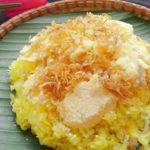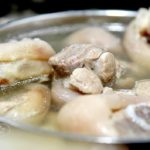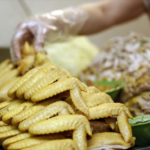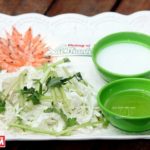 |
| The Moc Van Am is a collection of five meatballs in five colors, symbolizing the Five Elements, and is a wish for a prosperous New Year. This unique dish is a specialty of Hanoi’s culinary expert, Nguyen Phuong Hai. |
Moc, or steamed pork meatballs, have been around since the Le Dynasty and originated in Moc Village, now located in Nhan Chinh Ward, Thanh Xuan District, Hanoi. This village was also home to many ancient royal cooks. Legend has it that one of them created Moc Van Am, served it to the king, and was rewarded handsomely. From then on, the dish was exclusively offered to the king or served at banquets hosted by him. Over time, Moc Van Am has become a staple on the Tet menu of Hanoi’s commoners.
The main ingredients for Moc Van Am are raw pork paste and two types of pork rind. Firstly, shreds of pork skin are mixed with shredded white wood ear, raw pork paste, pepper, and spices. Thorough mixing is necessary for crispy and chewy meatballs. This step often required the grandmothers to take a breather.
Meanwhile, some of the pork rinds are boiled and added to the broth, creating the appearance of wisps of cloud in the jelly – hence the name ‘van am’ or ‘cloudy’. Unfortunately, this characteristic has been forgotten by even the oldest Hanoi cooks.
 |
| A traditional Vietnamese Tet feast prepared by culinary expert Nguyen Phuong Hai. |
The second type of pork rind is obtained by deodorizing pork rind with chopped ginger wine. Boiled in the broth and with the skimming of scum, spices are added. Additionally, pork shoulder and leg bones can be included, soaked in salt water and ginger wine, and blanched before boiling. Some families even add dry-roasted peanut worms and simmer the broth for several hours until it turns clear and ivory-colored.
Moving on to the meatballs, for coloring, green can be obtained from medicinal herbs like Sabah snake grass, Chinese folding leaves, pandan leaves, and magenta leaves; yellow from gardenia seeds soaked in boiling water; red from gac fruit seeds beaten with strong wine; black from chopped wood ear or shiitake; and white from the pork paste mixed with white wood ear.
The mixture of pork rind shreds, diced neck fat, and white wood ear is divided into five portions, each mixed with one of the colorings using separate utensils. When kneading the meatballs, a little water is applied to the palm of the hand – this step should be done with clean, bare hands. The meatballs should be slightly larger than a large Indochina dragon plum or the size of a peeled water chestnut, and flattened.
Once steamed, the meatballs are left to cool and arranged in small bowls. The order of arrangement follows the cycle of mutual generation. Specifically, the white ball (metal) is followed by the black ball (water), the green ball (wood), the red ball (fire), and the yellow ball (earth) – which is placed next to the white ball on the other side.
 |
| Moc Van Am is a delicate, beautiful, and tasty dish of ancient Hanoi. |
The five planets are embellished with wisps of cloud created by scattering pork rind pieces around the bowl and pouring cooled boiling water in. Nowadays, refrigerators make it easy for the broth to gel, but in the past, it required frosty weather.
The finished bowl of Moc Van Am is first offered to the ancestors on the altar. When the incense burning is over, the grandmother would gently shake the bowl and place it upside down on a plate. Removing the bowl would reveal a delicious and surprising cloudy meat jelly that would amaze all the family members gathered around the tray!
A cooking instructor and a native of Hanoi recreated this dish a few years ago and invited me to try it. The dish was beautifully presented, just like in the old days. Silently, I wished there were a few clouds of rind floating at the bottom of the dish. The size of the dish was slightly larger compared to the one my grandmother made, as far as I remember. For many years, my family stopped making this dish for Tet because it was challenging to prepare. However, an old-fashioned Tet feast with “six bowls and eight plates” would be incomplete without Moc Van Am.
Hue Rice Vermicelli Soup
Hue rice vermicelli soup is a popular dish both in the north and the south of Vietnam. The dish has a typical sweet taste of mam ruoc (a special shrimp paste in the south), the aroma of lemongrass and the peppery flavour of stewed dried chilli. Rice vermicelli threads used for the dish must be white, soft and big.
Vietnamese Chicken with Noodles
Summer is coming, and the heat usually makes people lose their appetite, especially for hot or spicy food. VNP introduces a light and fresh dish which is really suitable for the hot weather – Pho ga tron, or the Vietnamese chicken with noodles. The light and fresh dish is prepared based on the traditional dish of Pho ga (Noodles and chicken soup).








